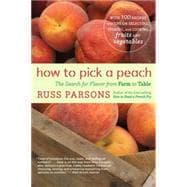
Note: Supplemental materials are not guaranteed with Rental or Used book purchases.
Purchase Benefits
What is included with this book?
| The Vegetables and Fruits Alphabetically | p. xi |
| The Recipes by Category | p. xiii |
| Introduction | p. 1 |
| The Plant Designers: Factories in the Field | p. 21 |
| Spring | |
| Artichokes | p. 35 |
| Asparagus | p. 47 |
| Onions, Leeks and Garlic | p. 59 |
| Peas and Fava Beans | p. 74 |
| Salad Greens | p. 86 |
| Strawberries | p. 101 |
| Big Farmers, Small Farmers: The Cost of Compromise | p. 113 |
| Summer | |
| Corn | p. 129 |
| Cucumbers | p. 140 |
| Eggplants | p. 146 |
| Green Beans | p. 154 |
| Summer Squash | p. 160 |
| Tomatoes | p. 169 |
| Cherries | p. 181 |
| Grapes | p. 190 |
| Melons | p. 198 |
| Peaches and Nectarines | p. 209 |
| Plums | p. 218 |
| Growers and Global Competition: Reinventing the Tomato | p. 223 |
| Fall | |
| Broccoli and Cauliflower | p. 235 |
| Mushrooms | p. 248 |
| Peppers | p. 256 |
| Winter Squash | p. 267 |
| Apples | p. 279 |
| Pears, Asian Pears and Quinces | p. 288 |
| Persimmons and Figs | p. 304 |
| Market Corrections: The Return of the Small Farmer | p. 311 |
| Winter | |
| Cabbages and Brussels Sprouts | p. 321 |
| Cooking Greens | p. 330 |
| Potatoes | p. 339 |
| Root Vegetables | p. 349 |
| Lemons and Limes | p. 364 |
| Mandarins (Tangerines), Grapefruits and Pummelos | p. 376 |
| Oranges | p. 384 |
| Index | p. 395 |
| Table of Contents provided by Ingram. All Rights Reserved. |
The New copy of this book will include any supplemental materials advertised. Please check the title of the book to determine if it should include any access cards, study guides, lab manuals, CDs, etc.
The Used, Rental and eBook copies of this book are not guaranteed to include any supplemental materials. Typically, only the book itself is included. This is true even if the title states it includes any access cards, study guides, lab manuals, CDs, etc.